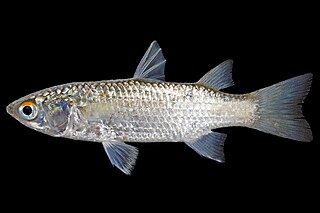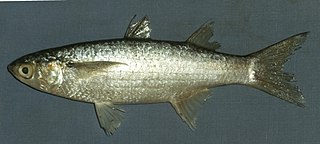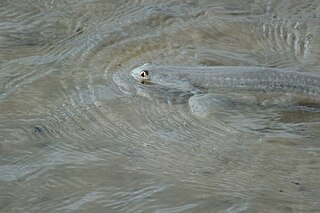
The mullets or grey mullets are a family (Mugilidae) of ray-finned fish found worldwide in coastal temperate and tropical waters, and some species in fresh water. Mullets have served as an important source of food in Mediterranean Europe since Roman times. The family includes about 78 species in 26 genera.

The flathead grey mullet is an important food fish species in the mullet family Mugilidae. It is found in coastal temperate, tropical and subtropical waters worldwide. Its length is typically 30 to 75 centimetres. It is known with numerous English names, including the flathead mullet, striped mullet, black mullet, bully mullet, common mullet, grey mullet, sea mullet and mullet, among others.
Chelon is a genus of mullets found in coastal marine waters, estuaries and rivers in the Atlantic Ocean and Arabian Sea.

Crenimugil is a genus of mullets found in coastal marine waters and rivers in the Indo-Pacific region.

Mugil is a genus of mullet in the family Mugilidae found worldwide in tropical and temperate coastal marine waters, but also entering estuaries and rivers.

The sand grey mullet is a species of mullet found in coastal marine waters of Australia.

The least rasbora or exclamation point rasbora is a species of ray-finned fish in the genus Boraras, native to freshwater habitats in mainland southeast Asia. This species is very small, ranging from 12 to 16 mm.

Diplodus sargus, the sargo, common white seabream, or white seabream is a species of marine ray-finned fish belonging to the family Sparidae, which includes the seabreams and porgies. This fish is found in the eastern Atlantic Ocean and in the Mediterranean Sea. It is a target species for commercial fisheries and is grown in aquaculture. D. sargussensu lato was formerly thought to be a widespread species in the eastern Atlantic and western Indian Oceans but the taxa outside of D, sargussensu stricto are now recognised as valid species and are part of the D. sargus species complex.

Rhabdosargus holubi, the Cape stumpnose, is a species of fish in the seabream family, Sparidae. It is native to southern Africa, where it can be found mainly along the eastern coast of South Africa.

Planiliza is a genus of mullets found in coastal marine waters, estuaries and rivers in the Indo-Pacific.

Osteomugil is a genus of mugilid mullets found in coastal waters of the Indo-Pacific, including estuaries and rivers. They were formerly included in Moolgarda and Valamugil.

Planiliza carinata, the keeled mullet, is a species of grey mullet from the family Mugilidae which is found in the western Indian Ocean and eastern Mediterranean Sea. It colonised the Mediterranean by Lessepsian migration from the Red Sea through the Suez Canal. The keeled mullet is a species of minor importance in commercial fisheries.

The squaretail mullet, also known as the diamondscale mullet, is a species of grey mullet from the family Mugilidae. It is an Indo-Pacific species and is the only species in the monospecific genus Ellochelon.
The Diassanga mullet is a species of ray-finned fish, grey mullet from the family Mugilidae. It is found in the eastern Atlantic around the coasts of West Africa.

The grooved mullet is a species of ray-finned fish, a grey mullet from the family Mugilidae. It is found in the coastal waters of the eastern Atlantic Ocean off the western coast of Africa, as far north as Mauritania, and into the western Indian Ocean.
Chelon tricuspidens, the striped mullet, is a species of ray-finned fish from the family Mugilidae. It is found in southern Africa where its known range comprises Mossel Bay and the Kosi Estuary in South Africa. Its habitatis muddy areas in estuaries. This species and the Diassanga mullet are closely related and these two taxa seem to have separated when the Benguela Current, as it exists today, was formed about 3-12 million years ago.

The flat-tail mullet is a species of grey mullet from the family Mugilidae. It is endemic to southern Australia where it forms schools in shallows, and lower estuaries, as well as in more saline lagoons. It spawns at sea but juveniles move into freshwater until they are a year old. It feeds on benthic microorganisms such as crustaceans and filamentous algae. It is caught as a food fish. It is the only species in the monospecific genus Gracimugil.
The sicklefin mullet is a species of ray-finned fish, a grey mullet from the family Mugilidae which is found in the eastern Atlantic Ocean of the coasts of western Africa. It is the only species in the monospecific genus Neochelon.

The shark mullet, also known as the sharp-nosed mullet, popeye mullet, or skipjack mullet, is a species of ray-finned fish from the grey mullet family Mugilidae. It is found in Australia and New Guinea where it occurs in muddy freshwater habitats and mangroves, it feeds on algae and insects taken from the surface but also on benthic invertebrates. It can breathe air and sometimes moves over exposed mud by wriggling. It was formerly classified in the genus Rhinomugil, with the corsula, but is now placed in its own monospecific genus, Squalomugil.
The pinkeye mullet, also known simply as pinkeye, or freshwater mullet, Richmond mullet, or river mullet, is a species of ray-finned fish from the grey mullet family Mugilidae and the only species in the genus Trachystoma. It is endemic to northeastern Australia where it occurs from the Burnett River in Queensland to the Clyde River in New South Wales. It is a subtropical species which is found in deep, slow flowing sections of rivers as well as in estuaries although it moves into coastal seas to spawn. It feeds mainly on algae and plant material, as well as detritus and benthic invertebrates.















